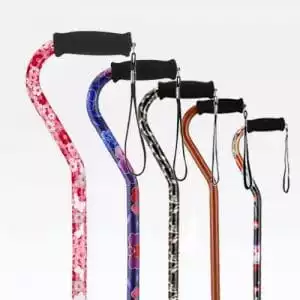Walking Canes for Sale
Being able to step out into the world with confidence–that’s priceless. Unfortunately, mobility challenges and pain can significantly hamper your ability to keep up with everyday life. Just getting around the house can seem like an insurmountable challenge without the right support. Walking canes make it possible to continue with your independence and lifestyle even when conditions like arthritis or stroke recovery interfere.
Making the Decision to Use Mobility Aids
Deciding to use a cane is a big decision. If you’re considering making the move, understand that the decision can bring on a variety of emotions, both positive and negative. This is especially true if it’s your first time requiring mobility aids. These feelings are normal and to be expected. There is no shame in seeking the support you need to stay healthy, mobile, and well.
Should I Use a Cane?
Whether or not a cane is the right choice for you depends on your individual health perspective. We encourage you to speak with a physician or pharmacist for a one-on-one evaluation whenever possible to determine whether one of our walking canes for sale is right for you. As a general rule, patients who may benefit from the use of a cane typically struggle with or are healing from certain conditions like:
- Arthritis
- Strokes
- Polio
- Cerebral Palsy
- Multiple Sclerosis
- Chronic lower torso or limb pain
- Herniated or degenerated discs
- Birth deformities
- Broken bones
- Muscle weakness
- Certain neurological conditions
- Sprains, dislocations, and strains
This list is by no means exhaustive, nor does it indicate that every patient with these conditions will always require a cane.
How to Choose From the Many Walking Canes for Sale
As your Good Neighbor pharmacy, we understand that each time you purchase equipment from us, you are trusting us to help you find the best walking canes for your needs. Use the information in this guide as a reference, but feel free to contact the pharmacy directly if you need additional help in choosing one of our walking canes for sale.
Measuring for Your Ideal Height
Relax both of your arms–or one at a time if you require the other for stability–loosely by your sides. Then, measure the length from the wrist joint to the floor. This is your ideal cane length. Alternatively, you can take your total height and divide it by two for an approximation.
Picking a Grip
Once you determine how much support you require and your ideal cane length, it’s time to choose a grip, shaft, and tip. Grip is by far the most important decision because it can effectively predict how comfortable and stable your walking cane is when used outside of the store.
Grip Materials
Foam, memory foam, and gel grip handles are the most common grip style because they reduce irritation and pressure on the palm. Gel is especially effective for reducing sweating of the hand and palm, and may reduce the risk of slipping and sliding while you walk.
- Crook grips have simple, straight handles that form a simple bar or a slight C-curve. These are often the most affordable first-line choice for people who need low levels of support while walking.
- Offset grips form a J-shape, and may be better for patients who struggle with balance issues because they offset overall body weight for improved balance.
- Molded grips are designed to cradle the left or right palm specifically. The wider, contoured handle provides excellent stability and may improve results for patients with neurological conditions, weakness, numbness, or chronic pain.
Shaft Materials
Cane shafts vary in size, portability, and style. They may be made from wood, lightweight metals, hard plastic, ceramic, or even heavier metals like stainless steel. Generally, heavier walking canes will provide more stability, while lightweight versions are more portable.
Cane Tips
- Single-tips are exceptionally common and widely used in healthcare and rehabilitation centers all across the United States. Usually made from rubber or impact-absorbing plastic in a flared shape, they offer basic support that’s suitable for patients with low-to-moderate support needs.
- Quad-tips break off into four individual sections rather than just one. This may be more appropriate for patients who are recovering from weakness, strokes, or neurological events, but they can be slightly more cumbersome to use.
We are Here to Help!
Because using a walking cane can be detrimental if you engage with the cane incorrectly, the decision to purchase and use one should always begin with and be guided by a medical evaluation.
At Burt’s Pharmacy, we are honored to help you come to the best decision possible for your needs. We encourage you to consider us part of your medical care team, and are happy to show you our walking canes for sale first-hand. Call today to schedule a consultation or stop by the pharmacy for more information.
Showing the single result
-
View Product
Canes #1

 info@burtsrx.com
info@burtsrx.com
